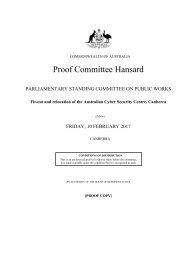SENATE
2e7N9wg
2e7N9wg
You also want an ePaper? Increase the reach of your titles
YUMPU automatically turns print PDFs into web optimized ePapers that Google loves.
86 <strong>SENATE</strong> Thursday, 13 October 2016<br />
Health risks are not the only impact on residents. Residential and business properties are deemed worthless,<br />
with banks not willing to provide loans against equity that would allow affected residents to relocate or carry out<br />
their own mitigation works. Valuers are not willing to put a valuation on any property in the red zone because of<br />
the contamination, and therefore the property owners have lost all their equity. As a result, the residents feel<br />
trapped in their own homes, unable to carry out any remediation work or to relocate to a safer environment.<br />
During a briefing about three weeks ago from the Minister for Health and Aged Care and the Minister for<br />
Defence, I put a suggestion that the government consider meeting with major banks and the Real Estate Institute<br />
to implement a scheme to allow affected properties to retain their values, and as such restore the equity that<br />
existed prior to the contamination being publicly known. Defence Minister Payne agreed with that request and has<br />
kindly responded as in the motion. Towards the end of the briefing, and following concerns I raised in relation to<br />
mental health issues that I consider will soon arise, the health minister indicated to me that the University of<br />
Newcastle family action strategy was about to be announced by the government. The plan is to alert local<br />
practitioners of the human health programs in place to deal with any medical conditions that may be linked to the<br />
PFOS and PFOA contamination.<br />
A Senate inquiry in May was very critical of Defence's response to the contamination as 'slow and reactive' and<br />
'seemingly focused on limiting its liability rather than addressing the needs of residents'. This is borne out in a<br />
confidential report commissioned by Defence in 2003—yes, 2003, 13 years ago—when this contamination was<br />
first investigated. At the end of the executive summary of that report, it states:<br />
In addition to environmental harm, such obvious pollution incidents have the potential to seriously damage Defence's<br />
reputation as an environmental manager and good corporate citizen.<br />
It is apparent that Defence has covered up the contamination issue since 2003 and has not acted on any of the<br />
report's recommendations.<br />
I will highlight the key findings and recommendations to make the point. Some key findings of the report were:<br />
Defence currently uses—<br />
aqueous film forming foam—<br />
AFFF product that contains non-biodegradable … (PFOS/PFOA) that are environmentally persistent, bioaccumulative and<br />
toxic to animals and humans.<br />
PFOS is acutely toxic to frogs and honey bees. Both PFOS and PFOA have been implicated with a variety of cancers and<br />
toxic health effects in humans that have had long term exposure to products containing PFOS/PFOA.<br />
In 2002 the US EPA forced products containing PFOS/PFOA off the market.<br />
The repeated uncontrolled or poorly managed use of AFFF products that contain PFOS/PFOA is cause for major<br />
environmental and health concern. There is the risk that poor AFFF management practices across some of Defence’s facilities<br />
may have resulted in PFOS/PFOA contaminating of soil, surface water and groundwater, both on and off base. Furthermore,<br />
the biodegradable part of AFFF consumes a lot of oxygen as it breaks down. The consumption of oxygen may influence the<br />
biological/chemical/geological conditions of groundwater and surface waters by driving anaerobic systems and causing the<br />
asphyxiation of aquatic fauna.<br />
… … …<br />
The main issues associated with fire fighting foam waste-water management are based around how it is collected,<br />
contained and disposed of…. there are no regulatory actions that specifically encompass the use and disposal of products<br />
containing PFOS/PFOA.<br />
… … …<br />
Most reports distinctly state that fire fighting foam waste-water should not be disposed of into watercourses, soils, or foul<br />
stormwater drains …<br />
… … …<br />
Best management practice for AFFF waste-water, as indicated by reports and literature, include the appropriate collection<br />
and containment of AFFF waste-water, and disposal via a sewage treatment plant or by incineration.<br />
There has been some issues with AFFF waste-water affecting the oil separation process, with many separators requiring<br />
constant repairs or replacement.<br />
… … …<br />
In many cases across Defence the AFFF waste-water is being released into the environment … with the potential of AFFF<br />
pollutants … contaminating soil and groundwater on Defence bases as well as contaminating surrounding farm land and<br />
surface waters.<br />
The recommendations of the report were:<br />
CHAMBER















